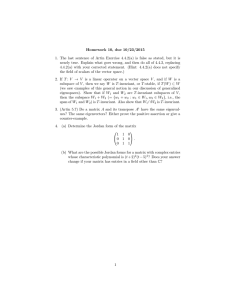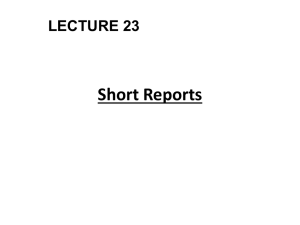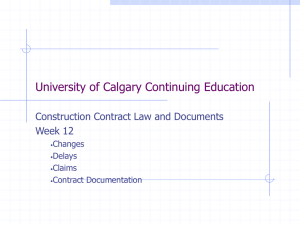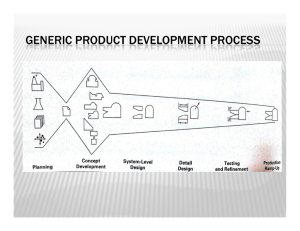Parameterization of Causal Stabilizing Controllers over Networks with Delays Michael Rotkowitz Abstract
advertisement
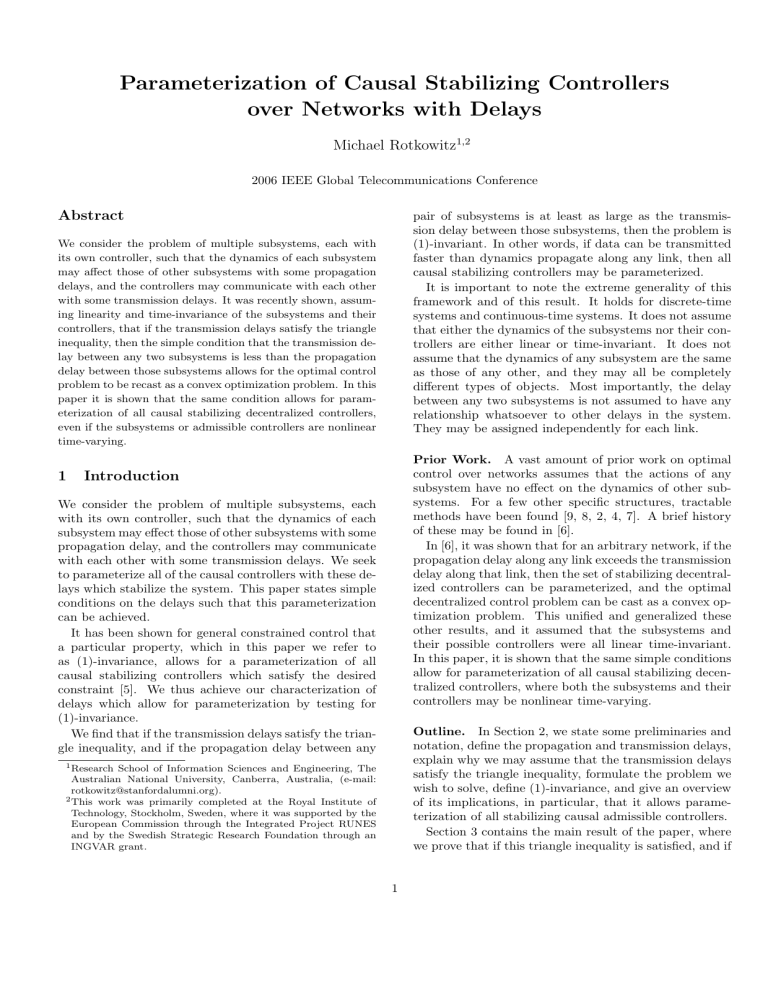
November 23, 2006 edited
Parameterization of Causal Stabilizing Controllers
over Networks with Delays
Michael Rotkowitz1,2
2006 IEEE Global Telecommunications Conference
Abstract
pair of subsystems is at least as large as the transmission delay between those subsystems, then the problem is
(1)-invariant. In other words, if data can be transmitted
faster than dynamics propagate along any link, then all
causal stabilizing controllers may be parameterized.
It is important to note the extreme generality of this
framework and of this result. It holds for discrete-time
systems and continuous-time systems. It does not assume
that either the dynamics of the subsystems nor their controllers are either linear or time-invariant. It does not
assume that the dynamics of any subsystem are the same
as those of any other, and they may all be completely
different types of objects. Most importantly, the delay
between any two subsystems is not assumed to have any
relationship whatsoever to other delays in the system.
They may be assigned independently for each link.
We consider the problem of multiple subsystems, each with
its own controller, such that the dynamics of each subsystem
may affect those of other subsystems with some propagation
delays, and the controllers may communicate with each other
with some transmission delays. It was recently shown, assuming linearity and time-invariance of the subsystems and their
controllers, that if the transmission delays satisfy the triangle
inequality, then the simple condition that the transmission delay between any two subsystems is less than the propagation
delay between those subsystems allows for the optimal control
problem to be recast as a convex optimization problem. In this
paper it is shown that the same condition allows for parameterization of all causal stabilizing decentralized controllers,
even if the subsystems or admissible controllers are nonlinear
time-varying.
1
Prior Work. A vast amount of prior work on optimal
control over networks assumes that the actions of any
subsystem have no effect on the dynamics of other subsystems. For a few other specific structures, tractable
methods have been found [9, 8, 2, 4, 7]. A brief history
of these may be found in [6].
In [6], it was shown that for an arbitrary network, if the
propagation delay along any link exceeds the transmission
delay along that link, then the set of stabilizing decentralized controllers can be parameterized, and the optimal
decentralized control problem can be cast as a convex optimization problem. This unified and generalized these
other results, and it assumed that the subsystems and
their possible controllers were all linear time-invariant.
In this paper, it is shown that the same simple conditions
allow for parameterization of all causal stabilizing decentralized controllers, where both the subsystems and their
controllers may be nonlinear time-varying.
Introduction
We consider the problem of multiple subsystems, each
with its own controller, such that the dynamics of each
subsystem may effect those of other subsystems with some
propagation delay, and the controllers may communicate
with each other with some transmission delays. We seek
to parameterize all of the causal controllers with these delays which stabilize the system. This paper states simple
conditions on the delays such that this parameterization
can be achieved.
It has been shown for general constrained control that
a particular property, which in this paper we refer to
as (1)-invariance, allows for a parameterization of all
causal stabilizing controllers which satisfy the desired
constraint [5]. We thus achieve our characterization of
delays which allow for parameterization by testing for
(1)-invariance.
We find that if the transmission delays satisfy the triangle inequality, and if the propagation delay between any
Outline. In Section 2, we state some preliminaries and
notation, define the propagation and transmission delays,
explain why we may assume that the transmission delays
satisfy the triangle inequality, formulate the problem we
wish to solve, define (1)-invariance, and give an overview
of its implications, in particular, that it allows parameterization of all stabilizing causal admissible controllers.
Section 3 contains the main result of the paper, where
we prove that if this triangle inequality is satisfied, and if
1 Research
School of Information Sciences and Engineering, The
Australian National University, Canberra, Australia, (e-mail:
rotkowitz@stanfordalumni.org).
2 This work was primarily completed at the Royal Institute of
Technology, Stockholm, Sweden, where it was supported by the
European Commission through the Integrated Project RUNES
and by the Swedish Strategic Research Foundation through an
INGVAR grant.
1
the propagation delay associated with any pair of subsystems is at least as large as the associated transmission
delay, then the information constraint is (1)-invariant,
and thus, we can parameterize all stabilizing causal controllers.
In Section 3.1 we break these total transmission delays
out into a pure transmission delay, representing the time
it takes to communicate the information from one subsystem to another, and a computational delay, representing
the time it takes to process the information before it is
used by the controller. We find, somewhat surprisingly,
that transmitting faster than the propagation of dynamics still allows for this parameterization, and in fact, that
the computational delay causes the condition to be relaxed.
We make some concluding remarks in Section 4.
2
y
r
November 23, 2006 edited
K
u
G
Figure 1: Interconnection of K and G
We say that G : Le → Le is strongly stabilizable iff
there exists K : Le → Le which is inc. stable and which
f.g. stabilizes G.
Delay. We define Delay(·) for a causal operator as the
smallest amount of time in which an it can affect its outn
put. For any causal H : Lm
e → Le ,
Preliminaries
Delay(H) = inf{τ ≥ 0 | z1 (T + τ ) 6= z2 (T + τ ),
All of the statements in this paper can be made both
for continuous time and for discrete time. Rather than
state each of these twice, we use T+ to refer to both R+
and Z+ , and then use Lm×n
to refer to the corresponding
e
or
extended space, which can then refer either to Lm×n
pe
`m×n
.
e
When the dimensions are implied by context, we omit
the superscripts of Lm×n
.
e
We define the truncation operator PT for all T ∈ T+
on all functions f : T+ → R such that fT = PT f is given
by
(
f (t)
if t ≤ T
fT (t) =
0
if t > T
z1 = H(w1 ), z2 = H(w2 ),
w1 , w 2 ∈ L m
e ,
w1 (t) = w2 (t) ∀ t ≤ T }
and if H = 0, we consider its delay to be infinite.
Note that we then have the following inequalities for
the delays of a composition or an addition of operators:
Delay(AB) ≥ Delay(A) + Delay(B)
Delay(A + B) ≥ min{Delay(A), Delay(B)}
We will need one more relation due to the nonlinearity of
the operators being considered.
An operator H : Le → Le is said to be causal iff
PT HPT = PT H
¡
¢
Delay((AB)kj ) = Delay g(∪ni=1 Aki Bij )
©
ª
≥ min Delay(Aki Bij )
∀ T ∈ T+
i
that is, iff future inputs can’t affect past or present outputs.
In the remainder of this paper, we assume that the
technical conditions of [5] hold.
In other words, g would typically be a summation, but
even if it is a more complicated function, the result still
cannot be any faster than its fastest component.
We suppose that there are n subsystems, each with its
own controller, and thus partition the sensor measurements and control actions as
£
¤T
£
¤T
y = y1T . . . ynT
u = uT1 . . . uTn
Stability. A causal operator H : Le → Le is said to be
finite gain stable, hereafter abbreviated as f.g. stable, iff
there exists γ < ∞ such that ∀ T ∈ T+ and ∀ x ∈ Le
and then partition G and K as
kPT Hxk ≤ γkPT xk
G11
..
G= .
Gn1
A causal operator H : Le → Le is said to be incrementally
stable, hereafter abbreviated as inc. stable, iff there exists
γ < ∞ such that ∀ T ∈ T+ and ∀ x, y ∈ Le
kPT Hx − PT Hyk ≤ γkPT x − PT yk
2.1
We say that K : Le → Le f.g. stabilizes G : Le → Le
iff for the interconnection in Figure 1 the maps from the
two inputs to the four other signals are all f.g. stable.
...
...
G1n
..
.
Gnn
K11
..
K= .
Kn1
...
...
K1n
..
.
Knn
Propagation Delays
For any pair of subsystems i and j we define the propagation delay pij as the amount of time before a controller
2
2006 edited
on the case where S is definedNovember
by delay23,
constraints
as
discussed above.
This problem is made substantially more difficult in
general by the constraint that K lie in the subspace S.
Without this constraint, a parameterization could be
achieved with a simple change of variables [3, 1].
action at subsystem j can affect an output at subsystem
i as such
pij = Delay(Gij )
2.2
∀ i, j ∈ 1, . . . , n
Transmission Delays
For any pair of subsystems k and l we define the (total)
transmission delay tkl as the minimum amount of time
before the controller of subsystem k may use outputs from
subsystem l. Given these constraints, we can define the
overall subspace of admissible controllers S such that K ∈
S if and only if
Delay(Kkl ) ≥ tkl
2.4
In this subsection we define an invariance condition
pertaining to information constraints, and give a brief
overview of results regarding this condition, in particular, that it allows parameterization of all causal stabilizing decentralized controllers.
We say (until a better name is established) that a set S
is (1)-invariant under G if
∀ k, l ∈ 1, . . . , n
In Section 3.1 we will break these total transmission
delays out into a pure transmission delay, representing
the time it takes to communicate the information from
one subsystem to another, and a computational delay,
representing the time it takes to process the information
before it is used by the controller.
K1 (I ± GK2 ) ∈ S
(1)
Theorem 1. Suppose that S is closed and that S is
(1)-invariant under G. Then
©
ª
K(I − GK)−1 | K ∈ S = S
It was further shown in [5] that this result could be
combined with those of [3, 1] to obtain the desired parameterization, when the plant is stable or unstable, respectively, as follows.
Suppose that G is inc. stable.
Then if S is closed and S is (1)-invariant under G, then
we get the following parameterization.
∀ k, i, j ∈ 1, . . . , n
This is typically a very reasonable assumption for the following reasons. tkj is defined as the minimum amount
of time before controller k can use outputs from subsystem j. Thus if there existed an i such that the inequality
above failed, that would mean that controller k could receive that information more quickly if it came indirectly
via controller i. We would thus reroute this information
to go through i, tkj would be reset to tki + tij , and the
inequality would hold.
2.3
∀ K 1 , K2 ∈ S
The following is the main result of [5]. It shows that
constraints satisfying this condition are invariant under
feedback.
Triangle inequality. For the main result of this paper,
we will assume that the triangle inequality holds amongst
the transmission delays, that is,
tki + tij ≥ tkj
Invariance Condition
{K : Le → Le | K f.g. stabilizes G, K ∈ S} =
©
ª
Q(I + GQ)−1 | Q : Le → Le , Q f.g. stable, Q ∈ S
We can generalize this to the case where the plant is unstable, provided that S is also a subspace, which it is for
the delay constraints considered in this paper, and provided that an admissible controller exists which is both
stable and stabilizing, i.e., if the plant is strongly stabilizable.
Suppose that Knom ∈ S is inc. stable, Knom f.g. stabilizes G, and
G̃ = G(I − Knom G)−1
Problem Formulation
Given a plant G and transmission delays tkl for each pair
of subsystems, we define S as above, and we would then
like to parameterize the following set
{K : Le → Le | K f.g. stabilizes G, K ∈ S}
This gives all of the admissible controllers which are
causal and stabilizing. The delays associated with dynamics propagating from one subsystem to another are
embedded in G. The subspace of admissible controllers,
S, has been defined to encapsulate the constraints on how
quickly information may be passed from one subsystem
to another. We call the subspace S the information
constraint.
Many constrained or decentralized control problems
may be expressed in this form. In this paper, we focus
is inc. stable.
For the remainder of this paper, we assume that for a
given S, that Knom and G̃ are defined in this manner.
Then if S is a closed subspace, and S is (1)-invariant
under G̃, then
©
ª
K : Le → Le | K f.g. stabilizes G, K ∈ S =
©
Knom + Q(I + G̃Q)−1 |
ª
Q : Le → Le , Q f.g. stable, Q ∈ S
3
November
23, 2006
Theorem 3. Suppose that G and
S are defined
as edited
above,
and that the transmission delays satisfy the triangle inequality. If
pij ≥ tij
∀ i, j
(3)
The main focus of this paper is thus characterizing delays for which S is (1)-invariant under G and G̃.
3
Conditions for Parameterization
then S is (1)-invariant under G. Further, given Knom ∈
S, S is (1)-invariant under G̃.
We first provide a sufficient condition for Condition (1)
to hold in terms of these delays.
Proof.
Suppose Condition (3) holds. Then for all
i, j, k, l we have
Theorem 2. Suppose that G and S are defined as above.
S is (1)-invariant under G if
tki + pij + tjl ≥ tkl
∀ i, j, k, l
tki + pij + tjl ≥ tki + tij + tjl
≥ tkl by the triangle inequality
(2)
Proof. Suppose K1 , K2 ∈ S. First, for any i, l,
¡
¢
Delay (GK2 )il
≥ min{Delay(Gij ) + Delay((K2 )jl )}
and thus by Theorem 2, S is (1)-invariant under G.
Now define
j
Š = {G : Le → Le | Delay(Gij ) ≥ tij
≥ min{pij + tjl }
j
The new notation is introduced only because the dimensions may differ from those of S. It is clear from the
above that S is (1)-invariant under any such G. Given
G1 , G2 ∈ Š, and following similar steps to those in the
proof of Theorem 2, for any k, l,
¡
¢
Delay (G1 (I ± Knom G2 ))kl
o
n
≥ min min{tki + tij + tjl }, tkl
Noting that
Delay(Iil ) =
(
∞
0
if i 6= l
if i = l
we then have
¡
¢
Delay (I ± GK2 )il
≥ min{Delay(Iil ), Delay((GK2 )il )}
(
minj {pij + tjl }
if i 6= l
≥
0
if i = l
i,j
≥ tkl
and so Š is (1)-invariant under Knom .
Then, by Theorem 1, G̃ ∈ Š, and thus S is (1)-invariant
under G̃.
and then for any k, l,
¡
¢
Delay (K1 (I ± GK2 ))kl
¢ª
©
¡
≥ min Delay((K1 )ki ) + Delay (I ± GK2 )il
i
o
n
≥ min min {tki + pij + tjl }, tkl
i6=l,j
o
n
= min min{tki + pij + tjl }, tkl
3.1
Computational Delays
In this section, we consider what happens when the controller of each subsystem has a computational delay ci
associated with it. The delay for controller i to use outputs from subsystem j, the total transmission delay, is
then broken up into a pure transmission delay and this
computational delay, as follows
i,j
So if Condition (2) holds, then
¢
¡
Delay (K1 (I ± GK2 ))kl ≥ tkl
∀ i, j}
∀ k, l
tij = ci + t̃ij
and thus
If we were to assume that the triangle inequality held
for the total transmission delays tij as before, then we
would simply get the same results as in the previous section with the substitution above. In particular, we would
find pij ≥ ci + t̃ij to be the condition for (1)-invariance.
However, there are many cases where it makes sense to
instead assume that the triangle inequality holds for the
pure transmission delays t̃ij , which is a stronger assumption.
In this section we derive conditions for (1)-invariance
when we can assume that the triangle inequality holds for
the pure transmission delays t̃ij .
K1 (I ± GK2 ) ∈ S
Main Result. The following is the main result of this
paper. It states that if the transmission delays satisfy the
triangle inequality, and if the propagation delay between
any pair of subsystems is at least as large as the transmission delay between those subsystems, then the information constraint is (1)-invariant. In other words, if along
any link, data can be transmitted faster than dynamics
propagate, then all causal stabilizing decentralized controllers can be parameterized.
4
4
As before, the propagation delays are defined as
pij = Delay(Gij )
for all i, j
for all k, l
Thus the condition from Theorem 2 becomes
ck + t̃ki + pij + cj + t̃jl ≥ ck + t̃kl
∀ i, j, k, l
which reduces to
t̃ki + pij + cj + t̃jl ≥ t̃kl
∀ i, j, k, l
(4)
The following theorem gives conditions under which the
information constraint is (1)-invariant. It states that if
the triangle inequality holds amongst the pure transmission delays, and if Condition (5) holds, then the information constraint is (1)-invariant. Surprisingly, we see that
the computational delay now appears on the left side of
the inequality. In other words, not only does transmitting data faster than dynamics propagate still allow for
parameterization when we account for computational delay, but the condition is actually relaxed.
References
[1] V. Anantharam and C. A. Desoer. On the stabilization of nonlinear systems. IEEE Trans. Automat. Contr.,
29(6):569–572, 1984.
Theorem 4. Suppose that G and S are defined as above,
and that the pure transmission delays satisfy the triangle
inequality. If
pij + cj ≥ t̃ij
∀ i, j
[2] B. Bamieh and P. G. Voulgaris. Optimal distributed
control with distributed delayed measurements. In Proc.
IFAC World Congr., 2002.
(5)
[3] C. A. Desoer and R. W. Liu. Global parametrization
of feedback systems with nonlinear plants. Syst. Control
Lett., 1(4):249–251, 1982.
then S is (1)-invariant under G. Further, given Knom ∈
S, S is (1)-invariant under G̃.
[4] X. Qi, M. Salapaka, P.G. Voulgaris, and M. Khammash.
Structured optimal and robust control with multiple criteria: A convex solution. IEEE Trans. Automat. Contr.,
49(10):1623–1640, 2004.
Proof.
Suppose Condition (5) holds. Then for all
i, j, k, l we have
t̃ki + pij + cj + t̃jl ≥ t̃ki + t̃ij + t̃jl
≥ t̃kl
[5] M. Rotkowitz. Information structures preserved under
nonlinear time-varying feedback. In Proc. Amer. Control
Conf., 2006.
by the triangle inequality
and thus Condition (4) holds and S is (1)-invariant under G. This completes the proof for the stable case.
We can then similarly define
Š = {G : Le → Le | Delay(Gij ) ≥ t̃ij − cj
November 23, 2006 edited
We have studied the problem of parameterizing all stabilizing causal controllers for multiple subsystems subject
to constraints on how quickly they can share information.
In Theorem 3 we showed that, presuming the transmission delays satisfy the triangle inequality, if the transmission delay between any pair of subsystems is less than
the corresponding propagation delay, then the information constraint is (1)-invariant. This allows for parameterization of all causal stabilizing controllers.
We further showed that if we separately account for
computational delays, we still find that communicating
faster than dynamics propagate along any link allows for
this parameterization, and in fact, the condition becomes
relaxed.
and S is now defined such that K ∈ S if and only if
Delay(Kkl ) ≥ ck + t̃kl
Conclusions
[6] M. Rotkowitz, R. Cogill, and S. Lall. A simple condition
for the convexity of optimal control over networks with
delays. In Proc. IEEE Conf. Decision and Control, pages
6686–6691, 2005.
∀ i, j}
[7] M. Rotkowitz and S. Lall. A characterization of convex
problems in decentralized control. IEEE Trans. Automat.
Contr., 51(2):274–286, 2006.
so that S is clearly (1)-invariant under any such G. Given
G1 , G2 ∈ Š, and following similar steps to those in the
proof of Theorem 2, for any k, l,
¡
¢
Delay (G1 (I ± Knom G2 ))kl
o
n
≥ min min{t̃ki + t̃ij + t̃jl − cl }, t̃kl − cl
[8] P. G. Voulgaris. Control under structural constraints: An
input-output approach. In Lecture notes in control and
information sciences, pages 287–305, 1999.
i,j
[9] H. S. Witsenhausen. Separation of estimation and control
for discrete time systems. Proc. IEEE, 59(11):1557–1566,
1971.
≥ t̃kl − cl
and so Š is (1)-invariant under Knom .
Then, by Theorem 1, G̃ ∈ Š, and thus S is (1)-invariant
under G̃.
Thus we have shown that the triangle inequality and
Condition (5) are sufficient for Condition (1), that is, for
parameterization of causal stabilizing decentralized controllers.
5
